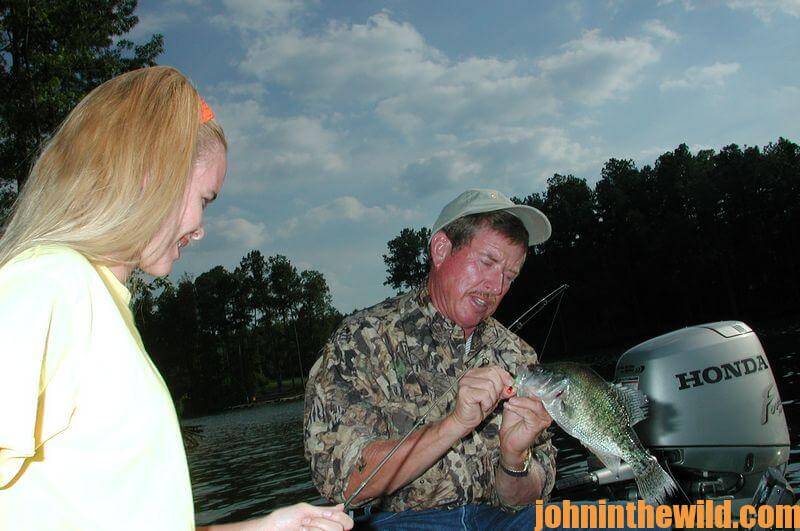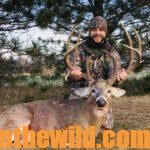 In many sections of the country, nighttime fishing for crappie is an important summer pastime. The advantage of using Cook’s system of finding crappie is that it will pay crappie dividends at night just as well as it will in the daytime. Many anglers opt for the opportunity to catch crappie in the summer after working hours as opposed to fighting the heat and the traffic on the lake during the day, especially on the weekends. The same river and creek ledges where you find the best pH and water temperature and cover on structure also will produce crappie at night. By using a light, you can draw in baitfish to your boat that will attract crappie. However, sometimes nighttime crappie are more mobile than daytime crappie in the summer. The problem with fishing for moving crappie is that a moving train of crappie doesn’t run on a regular schedule.
In many sections of the country, nighttime fishing for crappie is an important summer pastime. The advantage of using Cook’s system of finding crappie is that it will pay crappie dividends at night just as well as it will in the daytime. Many anglers opt for the opportunity to catch crappie in the summer after working hours as opposed to fighting the heat and the traffic on the lake during the day, especially on the weekends. The same river and creek ledges where you find the best pH and water temperature and cover on structure also will produce crappie at night. By using a light, you can draw in baitfish to your boat that will attract crappie. However, sometimes nighttime crappie are more mobile than daytime crappie in the summer. The problem with fishing for moving crappie is that a moving train of crappie doesn’t run on a regular schedule.
I remember one night several years ago when my cousin John Henry Berryhill and I had found an underwater creek point that dropped into an old river channel. We had fished the point from dark, using live minnows in about 18 feet of water. We were utilizing a light in the water to attract baitfish, but we’d only taken about eight crappie. We were weary of the fishing but little catching as our eyelids often dropped to half shut and then sometimes all the way closed from the boredom. Then for some unknown reason, at 1:00 am, the crappie train that was running down that creek channel and along that river ledge pulled into the spot where we were fishing. We had non-stop action until daylight and took 98 slabs – just two fish short of our legal limit.
 So, just because you find all the ingredients that Ken Cook describes (see Day 2), you can’t always bet that the crappie will be on those kinds of spots at the time you’re fishing them. However if you fish these places often enough or have several locations to fish, you can and will catch crappie consistently.
So, just because you find all the ingredients that Ken Cook describes (see Day 2), you can’t always bet that the crappie will be on those kinds of spots at the time you’re fishing them. However if you fish these places often enough or have several locations to fish, you can and will catch crappie consistently.
Another area that provides cover in deep water along creek channels and river ledges is bridge pilings and railroad trestles that cross major creek and river channels. During the hot summer months, these vertical structures that go from the bottom to above the surface allow a crappie to hold in any depth of water. Plus, if there’s current coming through the lake, the bridge pilings offer a current break where baitfish and crappie can hold. So, fishing bridge pilings either by day or night can pay major crappie dividends for the summertime crappie angler.
A third tactic that anglers can use once they understand the three steps to finding crappie is what I call the buoy tactic. Once you locate the proper water depth with the right temperature and right amount of oxygen content that intersects a creek or river channel, you can buoy off 200 – 300 yards of the edge of an old creek channel and then motor your boat between your buoys. Although crappie prefer to hold on cover, large schools of crappie will travel up and down these edges, feeding, swimming together and moving from location to location. When you see a school of fish on your depth finder between the buoys you have out, drop another buoy to mark the school. I’ve found as many as three different schools of crappie within 100 yards along the edge of an old creek channel.
 Then go back, and fish for the crappie in each school that you’ve marked. When one school of crappie quit biting, move on to the next buoy, and fish another school. After you’ve fished all the schools you’ve marked, and the fish have quit biting, you can pick up your buoys, run the same 100 yards of underwater creekbank, often relocate the schools, re-buoy them off and continue to fish successfully. Or, mark another 100 yards of underwater creekbank, and repeat the same procedure. By marking the edges, looking for the fish and buoying off the fish, anglers often can take large numbers of good-sized crappie all day long along the edge of one channel in the summer. Don’t forget that crappie don’t vanish after the spawn. They move to other types of cover, and different tactics must be used to catch them.
Then go back, and fish for the crappie in each school that you’ve marked. When one school of crappie quit biting, move on to the next buoy, and fish another school. After you’ve fished all the schools you’ve marked, and the fish have quit biting, you can pick up your buoys, run the same 100 yards of underwater creekbank, often relocate the schools, re-buoy them off and continue to fish successfully. Or, mark another 100 yards of underwater creekbank, and repeat the same procedure. By marking the edges, looking for the fish and buoying off the fish, anglers often can take large numbers of good-sized crappie all day long along the edge of one channel in the summer. Don’t forget that crappie don’t vanish after the spawn. They move to other types of cover, and different tactics must be used to catch them.
To learn much more about crappie fishing, get John E. Phillips’ Kindle eBooks and some print books, “Crappie: How to Catch Them Fall & Winter,” “Crappie: How to Catch Them Spring and Summer,” “Catch Crappie All Year” and “Catch Cold Water Crappie Now.” Click here to get these books. You also can download for free John and Denise Phillips’ “The Crappie Catcher’s Cookbook” here.










